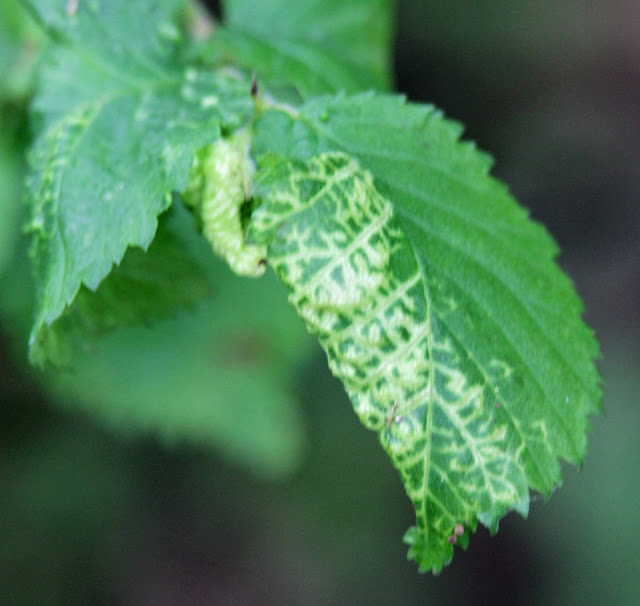Out of the wind in the clearing by the Red Pond.
In the shelter of the clearing by the Red Pond it was possible to take some photos of some of the flies and bees on the still leaves.
Nomada flava.
Here is a study of what looks to me like a male Nomada flava or Nomada panzeri. It is a male because of the greenish eyes and the 13 segment antennae. However it is a very dark individual on the top of the thorax and the head, particularly where I think I should be seeing two orange spots on the post-scutellum, it does look very dark indeed. I don't think ultimately this finally prevents this bee being either N. flava or N. panzeri, but it is confusing. The other two bees seen today up at Dene Park were definitely redder on their thoracic tops. They were also much paler orange on the antennae than this individual whose antennae are really quite dark brown. I do wonder if there is any variation in age or another factor.
However having looked at Jeremy Early's Flickr pages the darkness of the thorax and the antennae doesn't seem that unusual - in males. Having looked at this page, it is the females that have the reddish striped thoraxes, with the more orange antennae. Now everything makes sense, the two insects seen up at Dene Park are females if I look carefully at their antennae.
So I think the most likely species is N. flava, which parasitises Andrena species such as Andrena carontonica. Here is the male I saw in the shelter by the Red Pond, on leaves at about chest height.
It is unlikely to be N. leucophthalma because that is a rarer heathland species.
It is unlikely to be N. sigmata, because the yellow bars are interrupted centrally to some extent by reddish central markings, and this should not be so in N. sigmata. That species is very rare and also there are no yellow markings on the propodeum in these pictures which N. sigmata should have.
On the picture above and the one below I think you can see the palere undersaide to the scape, an important point in the key separating out N. flava/panzeri from N. ruficornis. This is very useful as I have not been able to check if the jaw was forked as in N. ruficornis.
For further information on Nomada flava here is a link to a BWARS picture of a Nomada flava male. http://www.bwars.com/index.php?q=bee/apidae/nomada-flava
Here is a link to the wildlife of Leicester and Rutland site, with quite a few nice profiles of Nomada species listed. http://www.naturespot.org.uk/taxonomy/term/19397
And here is a link to Nottinghamshire's Eakring site, http://www.eakringbirds.com/eakringbirds2/insectinfocusnomadaflava.htm.
This is Steven Early's Flickr page - its extremely useful for variations as well as confirmation. https://www.flickr.com/photos/63075200@N07/sets/72157633441342695/
This is a useful Danish site, with some staged specimens. http://www.rutkies.de/bienen-8/index.html
In the shelter of the clearing by the Red Pond it was possible to take some photos of some of the flies and bees on the still leaves.
Nomada flava.
Here is a study of what looks to me like a male Nomada flava or Nomada panzeri. It is a male because of the greenish eyes and the 13 segment antennae. However it is a very dark individual on the top of the thorax and the head, particularly where I think I should be seeing two orange spots on the post-scutellum, it does look very dark indeed. I don't think ultimately this finally prevents this bee being either N. flava or N. panzeri, but it is confusing. The other two bees seen today up at Dene Park were definitely redder on their thoracic tops. They were also much paler orange on the antennae than this individual whose antennae are really quite dark brown. I do wonder if there is any variation in age or another factor.
However having looked at Jeremy Early's Flickr pages the darkness of the thorax and the antennae doesn't seem that unusual - in males. Having looked at this page, it is the females that have the reddish striped thoraxes, with the more orange antennae. Now everything makes sense, the two insects seen up at Dene Park are females if I look carefully at their antennae.
So I think the most likely species is N. flava, which parasitises Andrena species such as Andrena carontonica. Here is the male I saw in the shelter by the Red Pond, on leaves at about chest height.
It is unlikely to be N. leucophthalma because that is a rarer heathland species.
It is unlikely to be N. sigmata, because the yellow bars are interrupted centrally to some extent by reddish central markings, and this should not be so in N. sigmata. That species is very rare and also there are no yellow markings on the propodeum in these pictures which N. sigmata should have.
On the picture above and the one below I think you can see the palere undersaide to the scape, an important point in the key separating out N. flava/panzeri from N. ruficornis. This is very useful as I have not been able to check if the jaw was forked as in N. ruficornis.
For further information on Nomada flava here is a link to a BWARS picture of a Nomada flava male. http://www.bwars.com/index.php?q=bee/apidae/nomada-flava
Here is a link to the wildlife of Leicester and Rutland site, with quite a few nice profiles of Nomada species listed. http://www.naturespot.org.uk/taxonomy/term/19397
And here is a link to Nottinghamshire's Eakring site, http://www.eakringbirds.com/eakringbirds2/insectinfocusnomadaflava.htm.
This is Steven Early's Flickr page - its extremely useful for variations as well as confirmation. https://www.flickr.com/photos/63075200@N07/sets/72157633441342695/
This is a useful Danish site, with some staged specimens. http://www.rutkies.de/bienen-8/index.html























































